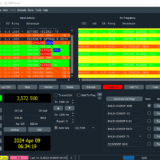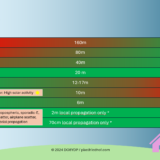Affinity Photo: Create Focus Stacking Merge from HDR images
I love Affinity Photos features to create HDR shots and focus stacks. These two functions let us create beautiful images.
So far I’ve always had to choose one or the other kind of image editing, but can’t we also create an image that consists of both HDR and Focus Stacking? Yes we can.
What is HDR, what is Focus Stacking?
If you know what HDR and Focus-Stacking is, you can skip this paragraph. For everyone else, here is a rudimentary explanation:
HDR photos are characterized by a high level of detail. Normally I take 5 or at least 3 pictures of the same subject for an HDR image. For simplicity’s sake we assume three pictures.
By using different exposure settings of the camera I take three pictures:
- First shot overexposed: Dark areas of the subject are taken clearly visible, bright and normal areas are overexposed.
- Second shot normally exposed: Center areas of the subject are clearly visible, bright and dark areas are overexposed or underexposed.
- Third shot underexposed: Bright areas of the subject are clearly visible, dark and normal areas are underexposed.
The three photos I took are now combined to one picture in the HDR workflow. Thereby I reject the overexposed and underexposed areas and only assemble my picture from the well taken components.
Thus I get perfect visibility of all details, no matter if in a dark, normal or light area of the motive. If I want to capture the details even more granularly, I even take 5 shots with different exposures instead of our exemplary 3 shots.
Focus Stacking also describes a workflow in which I combine several images into one image. But this time it’s not about details, but about the sharpness of the subject.
I take three pictures by changing the focus on the lens:
- First shot with focus on objects close to the camera (almost at the close-up limit of the lens).
- Second shot with focus on objects in the medium distance range from the camera (50% of the focus bandwidth)
- Third shot with focus on objects far away from the camera (near infinity range of the lens).
From these three shots, we only combine the sharp areas to form a new image. The result is an image which is characterized by enormous sharpness in all areas. There are no more blurred areas, no bokeh.
If I want to capture the different focus areas even more granularly, I even take 5 shots with different focus instead of our exemplary 3 shots.
HDR and Focus Stacking – Taking the photographs
First we set the camera for HDR: RAW image, middle aperture, usually 8, mirror lock up active, ISO value static, 3 (or 5) bracketing row with step size 1 active).
Under this link you will find an example video of the Nikon D500 setting for HDR recordings with bracketing, if you are not so familiar with the topic yet.
Of course we make all following recordings with the tripod.
- Shooting the first HDR exposure series with focus on close-up range
- Shooting of the second HDR exposure series with focus on medium distance range
- Shooting the third HDR bracket with focus on the area far away from the camera.
It is important that no settings are changed on the camera during the above shots, not even by the camera’s built-in auto modes. Only the focus may be changed.
HDR and Focus Stacking in the Affinity Photo Workflow – The Order Makes the Difference
First we create the respective HDR combinations from the three created recordings (New HDR combination in the menu). We should avoid excessive light edges.
We start with the HDR series with the middle focus. When we have finished assigning the tone values, we save all our development settings as presets.
Now we save the finished image as a .afphoto file. We save it as 8-bit, better as 16-bit image.
After editing the first row, we take the close and wide row. When developing the images, we simply call up the previously saved preset and do not change anything else.
We also save the images of the wide and close focusing as .afphoto files.
That’s it with HDR. Now we can dedicate ourselves to the Focus Stacking.
We now load these three created .afphoto-images into the Focus Merging Stack in the File / Focus Stacking menu to merge them into one Focus Stack.
The result is a focus merge from three HDR sources. In the ideal case high detail fidelity and sharpness in all image areas.
All the links in this text are Amazon Affiliate Links, and by clicking on an affiliate link I will earn a percentage of your subsequent Amazon purchases. However, this circumstance does not influence the background of my product recommendation. This product recommendation is independent, honest and sincere.
Bei allen genannten Links handelt es sich um Amazon-Affiliate-Links. Durch einen Klick auf einen Affiliate-Link werde ich prozentual an Euren darauf folgenden Amazon-Einkäufen beteiligt. Dieser Umstand beeinflusst aber nicht die Hintergründe meiner Produktempfehlung. Diese Produktempfehlung erfolgt unabhängig, ehrlich und aufrichtig.


